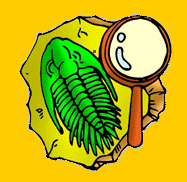Same Old, Same Old....
During the Ordovician Period
[oar-doh-VISH-ee-in], which lasted about 47 million years, the Taconic Orogeny and the accretion - or
'pasting-on' - of the Bronson Hill Complex
on the eastern shore of the Connecticut River Valley, continued.
These events were caused by the fact that the early North
American craton, Laurentia,
was colliding with Baltica - the European craton. (Both of these
events are described in the "Cambrian Period"
pages found on the Geologic Timeline at left.) Together with the
preceeding Cambrian Period,
the Ordovician Period was known as the 'Age of Invertebrates'.
Invertebrates are animals without backbones, such as snails and
clams.
Most of what would become New
Hampshire at this time was part of a small plate known as 'Avalonia'.
Avalonia was made up of what would one day be New England, Nova
Scotia and the British Isles. New Hampshire, and the rest of
Avalonia, had drifted north and west from its position near the South
Pole during the Cambrian Period. It now rested in the
Mid-Southern latitudes, nearly halfway to the Equator in the Southern
Hemisphere.
Something Fishy's Goin' On
The fact that the Ordovician
period was part of the 'Age of Invertebrates', meant that
invertebrates were the dominant animal type, not the only one. In
fact, it was during this period that the first vertebrates
(animals with backbones) started to show up in the fossil record.
[FYI - the individual bones in your spine are known as vertebra.]
Among the first vertebrates to show up were fish.
It Isn't Easy Being Green
At this point, we are just past
the 90 percent mark in Earth's Geologic History. To date, there
had been no plants or animals living on the dry land surface of the
planet. This was about to change. As mentioned in the Cambrian Period,
for most of Earth's history the dominant life form on Earth was
single-celled anearobic bacteria.
Over time, cyanobacteria (formerly known as blue-green algae) and
ocean living plants developed . Blue-green algae and plants
produced oxygen as a by product of photosynthesis -
which turned out to be poisonous to the original anaerobic bacteria.
Over millions and millions of years, the blue-green algae and
plants multiplied while bacteria slowly died out from the increase in
oxygen. The oxygen increased not only in the oceans, but also in
the atmosphere.
As plants increased their presence in the oceans, it was only a matter
of time before they started straying onto land, most likely in the
intertidal zone. The intertidal zone is that area of the
shoreline that lies between the high and low tide water levels.
Sometimes this zone is under water and sometimes it is exposed to
the air.
|
|
| Welcome to Avalonia! |
|

New Hampshire was once part of a small tectonic plate that was
separate from North America. This small plate was known as
Avalonia and included what today is Nova Scotia and the British Isles!
(Click on the image for a closer look.)
Image Credit:
Christopher Scotese; www.scotese.com
|
| In The
Zone |
|
 The intertidal
zone is where biologists believe the first land plants made their
appearance during the Ordovician Period. The intertidal
zone is where biologists believe the first land plants made their
appearance during the Ordovician Period.
(Click on the image for a closer look.)
Image Credit: Daniel
E. Reidy
|
Squishy or Fishy ?
|
|
 Invertebrates, (animals without
backbones) such as jellyfish, sea slugs and shellfish, were the
dominant animal type during the Ordovician Period. However,
fishes and other vertebrates (animals with backbones) started to make
their appearance in the fossil record at this time. Invertebrates, (animals without
backbones) such as jellyfish, sea slugs and shellfish, were the
dominant animal type during the Ordovician Period. However,
fishes and other vertebrates (animals with backbones) started to make
their appearance in the fossil record at this time.
|
Did You Know?
|
|
The Ordovician Period is
named after a Celtic tribe called the Ordovices.
|
|